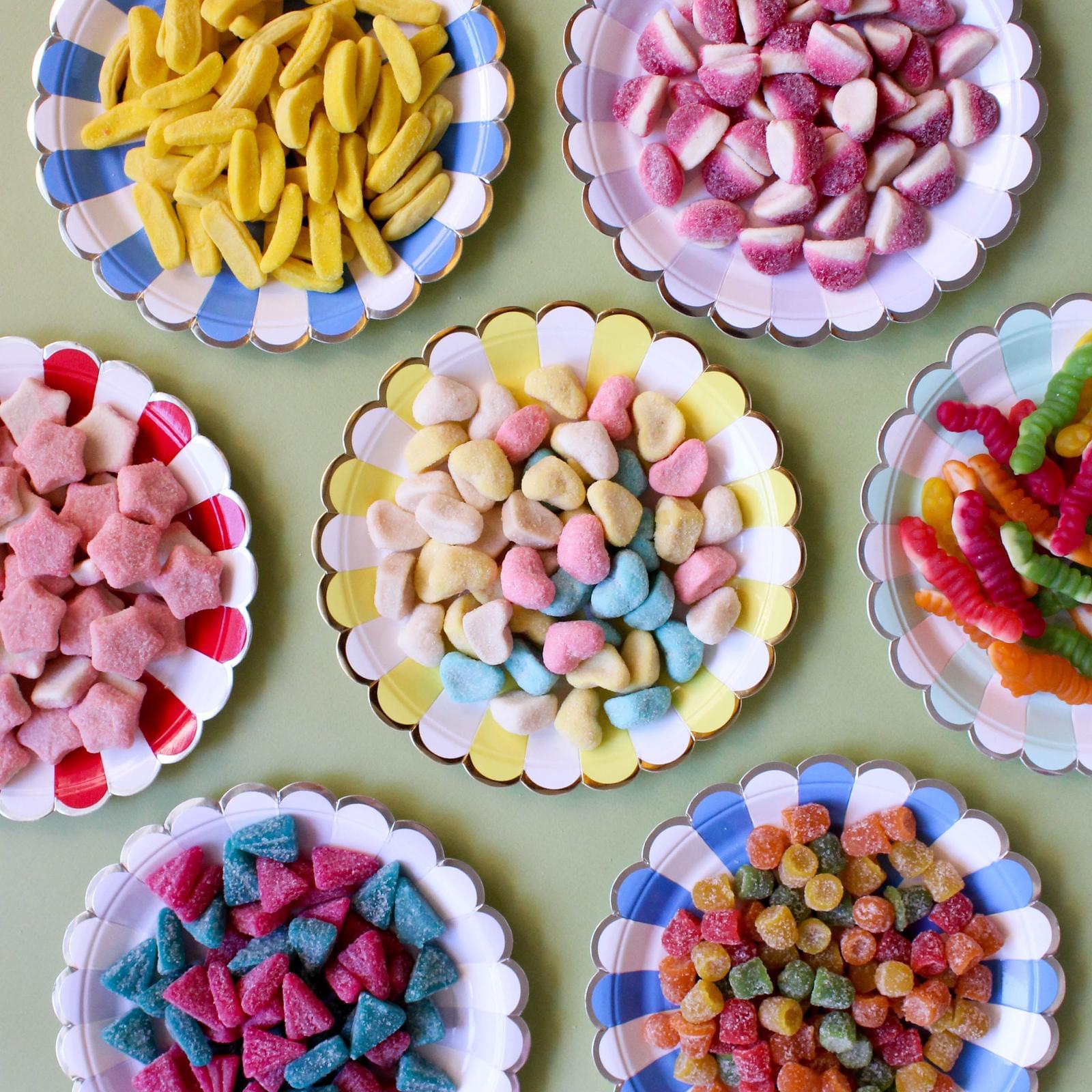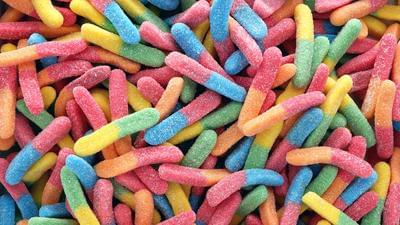Candy Extras

Candy comes with a bunch of little extras.
Bootstrap and JQuery and Friends
Candy comes with CSS and JS loaded from cdn sources baked in, ready to use. This includes minimized versions of Bootstrap 4 (CSS and JS), JQuery 3.3 (slim), Font Awesome, Google Fonts, Lodash, Parallax, and PopperJS.
Candy relies pretty heavily on Bootstrap CSS, but the others are optional. Don't want them? Just remove the import in layouts/base.njk.
PrismJS for Syntax Highlighting
Candy uses PrismJS for syntax highlighting of code blocks. It uses a customized version of Sulphurpool Light by Bram de Haan. For more, see src/scss/_prism-syntax.scss.
Markdown-it Emoji and Footnote support
Eleventy uses markdown-it to process Markdown files. Markdown-it supports plugins, and we include emoji and footnote support in our eleventy.js config:
let markdownIt = require("markdown-it");
let markdownItEmoji = require("markdown-it-emoji");
let markdownItFootnote = require("markdown-it-footnote");
let options = {
html: true
};
let markdownLib = markdownIt(options).use(markdownItEmoji).use(markdownItFootnote);
eleventyConfig.setLibrary("md", markdownLib);Candy Build Pipeline
Candy uses Yarn to manage dependencies and Gulp to manage the build process. Read more about the about the pipeline here.
Sass
A Gulp build task processes the src/*.scss files into a single minimized dist/css/main.css file. All colours and fonts are kept as variables in src/_variables.scss. Modifying this file alone can go a long way to customizing your site.
Generated RSS feed.xml
Candy produces a feed.xml for RSS. The nunjuck template is located at src/site/feed/feed.njk. Note that Candy uses the collections.stsop filter from eleventy.js config as the source the generated feed.xml,
Similar Posts
The custom nunjucks filter called "similar" has been created to generate a "Related Posts" section. The custom filter can be inspected at filters/similar.js.
The usage in nunjuck template looks like this: for simpost in collections.posts | similar(tags, page.url, 2, true) , where the inputs represent:
| Attribute | Description |
|---|---|
| sametags | set of tags for the current post |
| noturl | the current url, which should be excluded from the matching process |
| maxcount | the max number of similar posts to return |
| includestars | boolean to indicate if posts tagged star shown as should be given special preference |
The filter will iterate over all posts (except noturl) and determine a "match score" against the current post. For each common tag the match the score is incremented by +2. If "includestars" is true, then the match score is incremented an additiional +1 if the compareTo post is tagged "star".
A set of posts with the highest match score containing maxcount items is returned.
Favourite Posts
This is a simple filter on posts tagged as star and denoted by . Applies to both Blog and Portfolio items.
Favourite posts can be displayed by including either the star-list-col.njk or star-list-row.njk nunjuck template. The "-col" version is meant to display the thumbnails in a column (like in a sidebar), while "-row" shows them side-by-side in a Bootstrap row.
Tag List with Counts
Candy incorporates a sort of "tag cloud" which can be used as a widget in a sidebar by including tag-list-col.njk or in a full width page with tag-list-row.njk. This include will display a list of all tags in the project with a count of the number of blog or portfolio items share the tag.
Tags Page
All tags used in the project are listed on the tags page along with usage counts. Furthermore, the tags (in this list, as well as in all other pages) link directly to a /tags/#tagName hashtag target in tags page. At this target, we list thumbnails with excerpts of each post or photo that carries that tag.
SEO Optimizations
The Candy project contains a few basic elements designed for helping search engines find and evaluate content.
Generated sitemap.xml
Although crawlers can usually discover most of the well inter-linked site, a sitemap can improve the crawling of the site.[1]
Candy produces a basic (sitemap.xml)[/sitemap.xml] with the sitemap.xml.njk template. By default all site content will be included in the sitemap. Generated pages can be excluded by specifying excludeFromSitemap: true in the page front matter yaml.
Generated robots.txt
You can learn all about robots.txt at Moz.com. Candy help by creating a very basic robots.txt file from robots.txt.njk template.
Page meta data tags
The <title>...</title> tag[2] and <meta name="description" ...> tag[3] still have an important role in search. Candy helps.
Title tag
By default Candy will produce a <title>...</title> tag in the head of each generated document using the following rules:
- Each page extending
base.njkmust define a title value in front matter yaml. - If a
headTitlePreattribute is added to the front matter, then this text will be pre-pended to title. It is recommended that this value should represent a target keyword for the page and a dash or pipe separator. - If a
headTitlePostattribute is added to the front matter, then this text will be appended to title. It is recommended that this value should represent a branding opportunity by appending something like " | Candy" to all pages. - The pre+title+post value is truncated to 60 chars.
Meta Description tag
By default Candy will produce a <meta name="description" content="..." /> tag where the content value will be derived from:
- If page front matter yaml specifies a
metaDescription: xyzthenxyzwill be used, else ... - If an excerpt can be derived it will be used, else ...
- Page title will be used
In either case, the content value will be stripped of html and truncated to 280 chars.
Open Graph meta data tags
The Open Graph Protocol specifies a number of tags to assist with social content sharing. Candy has these built-in:
| Meta tag Name | Description |
|---|---|
| og:site_name | Value from metadata.json file "title" attribute |
| og:title | Value is generated with the same algorithm as the Title tag (described above) |
| og:description | Value is generated with the same algorithm as the Meta Description tag (described above) |
| og:url | Value is provided per page by Eleventy as absolutePostUrl |
| og:image | If the page front matter defines a mainImageFilename, then it is used. Otherwise, the site default og-image is used |
| og:image:width | If the page front matter defines a mainImageFilename and a mainImageSize, then the mainImageSize value is used. If the site default og-image.jpg is used, then the value is "279" |
| og:image:height | If the page front matter defines a mainImageFilename, then this value is not known and omitted. If the site default og-image.jpg is used, then the value is "279" |
Twitter meta tags
Twitter will honour Open Graph tags when present, but we do want to add a few meta tags spefically for twitter:
| Meta tag Name | Description |
|---|---|
| twitter:card | Value "summary_large_image" instruct twitter to share a large image from og:image |
| twitter:site | Value from metadata.json file "twitter" attribute. Represents the site's twitter handle |
| twitter:creator | Value from metadata.json file "author.twitter" attribute. Represents the author's twitter handle |


